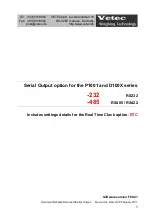LCD Module Overview
Interfacing an LCD to the MC9S08LC60, Rev. 0
Freescale Semiconductor
5
Another factor affecting power supply configuration has to do with the LCD glass panel. Typical driving
voltages for LCD glass panels are 3 V and 5 V. The subsequent sections summarize power supply
configuration options when driving both 3 V and 5 V LCD glass.
2.1.1
Configuration Options for 3 V LCD Glass
When driving 3 V LCD glass, the following configurations are available:
•
Power the LCD module via V
LCD
, where V
LCD
is nominally 1.5 volts, with the LCD module
configured for doubler mode.
•
Power the LCD module via V
DD
, where V
DD
is nominally 3 V, with the LCD module voltage
supply switch (VSUPPLY[1:0]) configured to generate V
LL3
from V
DD
•
Power the LCD module via V
DD
, where V
DD
is nominally 2 V, with the LCD module voltage
supply switch (VSUPPLY[1:0]) configured to generate V
LL2
from V
DD
2.1.2
Configuration Options for 5 V LCD Glass
When driving 5 V LCD glass, the following configurations are available:
•
Power LCD module via V
LCD
, where V
LCD
is nominally 1.67 volts, with the LCD module
configured for tripler mode.
•
Power the LCD module via V
DD
, where V
DD
is nominally 3.3 volts, with the LCD module voltage
supply switch (VSUPPLY[1:0]) configured to generate V
LL2
from V
DD
2.2
LCD Module Clock
illustrates the MC9S08LC60 clock source, which can either be sourced from the MC9S08LC60
internal clock reference or an external clock source. The LCD module is designed to operate using a
32.768 kHz clock regardless of clock source, so clock dividers must be used to achieve the target
32.768 kHz clock target. In
, the 32.768 kHz clock target is labeled LCDCLK. LCDCLK is used
to determine the following LCD operational settings:
•
LCD base frequency
•
LCD blink rate
•
LCD charge pump rate


















